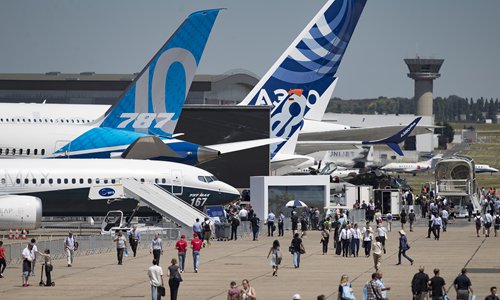HOME >> BUSINESS
New services, deals
Source:Global Times Published: 2019/10/24 18:53:40

File photo: IC
BoeingBoeing said on Wednesday that it has made progress over the past several months in supporting the safe return of the 737 MAX to service, as the company continues to work with the FAA and other global regulators on the process laid out for certifying the aircraft's software and related training updates. The company has also made governance and operational changes to sharpen its focus further.
In addition to providing assistance to those affected by the accidents which led to the grounding of the jet, teams from across Boeing and supplier partners have been working around the clock to develop software updates and conduct related flight testing, enhance future pilot training materials, engage and inform global regulators, airline customers and suppliers, and support the existing fleet of 737 MAX airplanes.
Meanwhile, the company said they are also taking steps to implement previously announced actions that will sharpen the focus on product and services safety.
Boeing has taken additional measures to increase its focus on operational excellence and strengthen how it manages safety across the company, its supply chain, and the broader aerospace community in an effort to advance global aviation safety.
Cathay Pacific
Cathay Pacific Group has released combined Cathay Pacific and Cathay Dragon traffic figures for September 2019, which show decreases in the number of passengers carried and the amount of cargo and mail uplifted compared to the same month in 2018.
Cathay Pacific and Cathay Dragon carried a total of 2,426,961 passengers last month - a drop of 7.1 percent compared to September 2018. In the first nine months of 2019, the number of passengers carried grew by 1.3 percent and capacity increased by 6.9 percent year-on-year.
The two airlines carried 172,637 tons of cargo and mail last month, a drop of 4.4 percent compared to the same month last year. The cargo and mail load factor fell by 3.7 percentage points to 65.5 percent.
Korean Air
From Sunday, Korean Air will operate the Incheon-Clark route seven times a week, the Incheon-Nanjing route four times a week and, from Monday, the airline will operate the Incheon-Zhangjiajie route three times per week and the Incheon-Hangzhou route twice per week.
In addition to the new services, Korean Air is also endeavoring to achieve route competitiveness and enhance profitability by expanding its capacity on Southeast Asia, China and Oceania routes, following the falling demand and capacity for Japanese routes.
IATA
The International Air Transport Association (IATA) announced global passenger traffic data for August 2019, showing that demand (measured in total revenue passenger kilometers or RPKs) climbed 3.8 percent compared to the same period the year before.
This was above the 3.5 percent annual increase for July. August capacity (available seat kilometers or ASKs) increased by 3.5 percent.
Load factor climbed 0.3 percentage points to 85.7 percent, which was a new monthly record, as airlines continue to maximize asset usage.
"This reflects the impact of economic slowdowns in some key markets, uncertainty over Brexit and the trade war between the US and China," said Alexandre de Juniac, IATA's Director General and CEO, in a note sent to the Global Times.
Global Times
Posted in: AVIATION